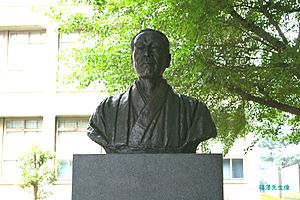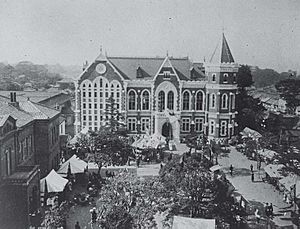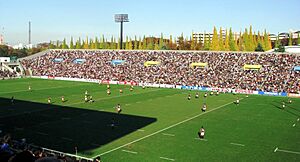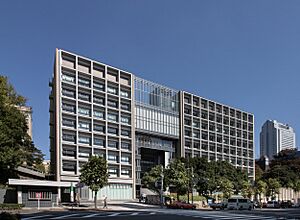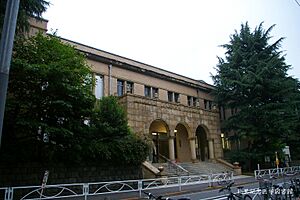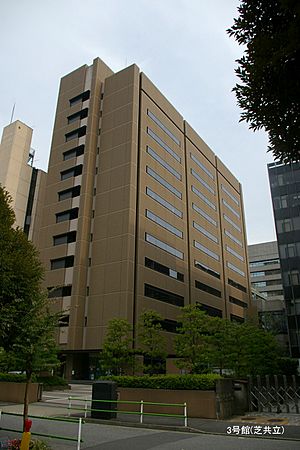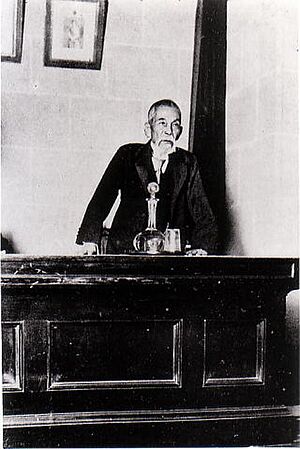Keio University facts for kids
|
慶應義塾大学
|
|||||
 |
|||||
| Motto | ペンは剣よりも強し Calamus Gladio Fortior |
||||
|---|---|---|---|---|---|
|
Motto in English
|
'The pen is mightier than the sword' | ||||
| Type | Private; Research University | ||||
| Established | 23 April 1858 | ||||
| Founder | Fukuzawa Yukichi | ||||
| Affiliation | AACSB, APRU, CEMS – The Global Alliance in Management Education, COBS, ASAIHL | ||||
| President | Kohei Itoh | ||||
|
Academic staff
|
2,791 full-time (As of May 1, 2022) | ||||
|
Administrative staff
|
3,252 full-time (As of May 1, 2022) | ||||
| Students | 33,437 (As of May 1, 2022) | ||||
| Undergraduates | 28,641 (As of May 1, 2022) | ||||
| Postgraduates | 6,222 (As of May 1, 2022) | ||||
| Location |
,
Tokyo
,
Japan
35°38′57″N 139°44′34″E / 35.64917°N 139.74278°E |
||||
| Campus | Urban | ||||
| Flag |  |
||||
| Colors | Gold, Navy Blue, and Red | ||||
| Mascot | Keio Unicorn | ||||
| Athletics | 43 Varsity Teams | ||||
| Japanese name | |||||
| Kanji | 慶應義塾大学 | ||||
| Hiragana | けいおうぎじゅくだいがく | ||||
|
|||||
Keio University (慶應義塾大学, Keiō Gijuku Daigaku), often called Keio (慶應) or Keidai (慶大), is a private research university in Minato, Tokyo, Japan. It started as a school for Western studies in 1858 in Edo. In 1920, it became one of Japan's first private universities.
Keio University is part of the Top Global University Project in Japan. This project helps fund top universities. Keio is also a member of important university groups like RU11 and APRU. It is one of only two Japanese universities, along with the University of Tokyo, in the World Economic Forum's Global University Leaders Forum.
Contents
About Keio University
Keio University began in 1858. Its founder, Fukuzawa Yukichi, had studied in the United States. He started teaching Dutch, which was a Western language at the time. In 1868, he changed the school's name to Keio Gijuku. He focused all his efforts on education.
At first, Keio was a private school for Western studies. Over time, it grew and added its first university departments in 1890. Keio has about 30 research centers today. These centers are on its five main campuses and other places in Japan. The Keio University Research Institute at SFC (KRIS) works with international groups like MIT and INRIA. They host the W3C.
As of June 2022, Keio University has the largest amount of money saved for its future among all Japanese universities. It has ¥78 billion. This is more than Waseda University (¥29 billion) and the University of Tokyo (¥15 billion).
History of Keio
Keio University (慶應義塾大学, Keiō Gijuku Daigaku) started in 1858. It was a school for Western studies in Tsukiji. Its founder was Fukuzawa Yukichi. The school's first name was "Shinshu Kan." It changed its name to "Keio Gijuku" in 1868. "Keio" came from the era name, and "Gijuku" means "private school."
The school moved to its current main location in 1871. It opened a medical school in 1873. In 1890, it added university departments for Economics, Law, and Literature.
| Year | University Development |
|---|---|
| 1858 | Keio Gijuku was established. |
| 1879 | Keio became a vocational school. It was funded by powerful families called daimyōs. |
| 1890 | Departments of Economics, Law, and Letters were started. |
| 1906 | Programs for graduate studies were established. |
| 1917 | The School of Medicine was established. |
| 1920 | Keio became an official university. This allowed it to give out degrees. |
| 1944 | The School of Technology was established. |
| 1949 | Keio was approved as a university in the post-war system. |
| 1957 | The School of Business and Commerce was established. |
| 1962 | The Graduate School of Business Administration was established. |
| 1981 | The Department of Science and Technology was established. |
| 1990 | The School of Environmental and Information Studies and the School of Policy Management were established. |
| 2001 | The School of Nursing and Medical Care was established. |
| 2004 | The School of Law was established. |
| 2008 | The School of Pharmacy was established. |
| 2008 | The Graduate School of Media Design was established. |
In 1899, Keio sent six students to study in other countries. In the same year, it welcomed three international students from India, China, and Siam. The next year, eight international students came from Taiwan. In 1946, Keio University started accepting female students. In 2006, a research paper was published in Science magazine. An undergraduate student was the main author.
Many famous people have visited Keio. In 1916, Bengali poet Rabindranath Tagore visited. In 1922, physicist Albert Einstein gave a special talk about his theory of relativity. In 2008, Prince Charles visited Keio University. In 2023, Sam Altman gave a lecture on campus.
University Presidents
Keio University has had 20 presidents since the system began in 1881.
| List of Presidents of Keio Gijuku | ||
|---|---|---|
| No. | President | Tenure |
| 1 | Sadashiro Hamano | 1881–1887 |
| 2 | Nobukichi Koizumi | 1887–1890 |
| 3 | Tokujiro Obata | 1890–1897 |
| 4 | Eikichi Kamata | 1898–1922 |
| 5 | Ichitaro Fukuzawa | 1922–1923 |
| 6 | Kiroku Hayashi | 1923–1933 |
| 7 | Shinzo Koizumi | 1933–1947 |
| 8 | Seiichiro Takahashi | 1946–1947 |
| 9 | Kouji Ushioda | 1947–1956 |
| 10 | Fukutaro Okui | 1956–1960 |
| 11 | Shohei Takamura | 1960–1965 |
| 12 | Kunio Nagasawa | 1965–1969 |
| 13 | Saku Sato | 1969–1973 |
| 14 | Hiroshi Kuno | 1973–1977 |
| 15 | Tadao Ishikawa | 1977–1993 |
| 16 | Yasuhiko Torii | 1993–2001 |
| 17 | Yuichiro Anzai | 2001–2009 |
| 18 | Atsushi Seike | 2009–2017 |
| 19 | Akira Haseyama | 2017–2021 |
| 20 | Kohei Itoh | 2021–Present |
Student Life at Keio
In 2021, Keio University had 33,469 students. This included 28,667 undergraduate students and 4,802 graduate students. About two-thirds of the students are male. However, the number of male and female students can be different in various study areas. For example, 56% of students in the Faculty of Letters are female. In the School of Medicine, about three-quarters of students are men.
| Undergraduate | Graduate (Master) | Graduate (Doctor) | Professional | Total | |
|---|---|---|---|---|---|
| Total | 28,667 | 3,034 | 1,408 | 360 | 33,469 |
| Male | 18,346 | 2,044 | 985 | 228 | 21,603 |
| Female | 10,321 | 990 | 423 | 132 | 11,866 |
| International | 874 | 861 | 1,735 | ||
On May 1, 2021, there were 1,908 international students. China sent the most international students with 1,016. South Korea was next with 436 students.
Student Clubs
In Japanese universities, student clubs are called "circles." Keio University has over 410 circles. These include both official and unofficial groups.
Sports and Athletics
Keio students have been interested in baseball since the early 1900s. In 1913, American baseball teams played an exhibition game against the Keio team. In 1932, the Keio team beat the University of Michigan team. Keio's baseball team plays in the Tokyo Big6 Baseball League.
Kei-So Rivalry
Keio University has a strong sports rivalry with Waseda University. They have many games each year in different sports. These sports include baseball, rowing, rugby, and more. These games are called "Kei–So Sen" or "So–Kei Sen."
The Kei-So baseball rivalry is over 100 years old. A famous game was played on October 16, 1943. This game was later shown in the 2008 film The Last Game – the Final So-Kei Sen.
American Football
Keio University also has an American football team, known as the Keio Unicorns football.
University Rankings
| THE National | General | 12 | |
|---|---|---|---|
| T. Reuters National | Research | 13 | |
| WE National | Employment | 3 | |
| NBP Greater Tokyo | Reputation | 3 | |
| Shimano National | Selectivity | SA | |
| QS Asia (Asia version) |
General | =48 | |
| THE Asia (Asia version) |
General | =197 | |
| THE World | General | 601–800 | |
| QS World | General | =215 | |
| ARWU World | Research | 301–400 | |
| ENSMP World | Alumni | 3 | |
| Social Sciences & Humanities | |||
|---|---|---|---|
|
LAW
|
|||
| Asahi National | Research | 2 | |
| Natural Sciences & Technology | |||
|
Engineering
|
|||
| QS World | General | 179 | |
| ** in | |||
Keio is a highly-ranked university. It ranks 53rd in the world in the Times Higher Education's Alma Mater Index. The Center for World University Rankings (CWUR) places Keio 34th globally and 3rd in Asia. Reuters ranks Keio 58th among the top 100 innovative universities worldwide.
The British company Quacquarelli Symonds (QS) ranked Keio 192nd in the QS World University Rankings for 2017/18. It was also ranked 45th for how well its graduates find jobs. In 2015, QS ranked Keio 37th in Asia. The Academic Ranking of World Universities (2015) ranked Keio between 151-175 in the world and 37th in Asia.
Research and Business Success
Thomson Reuters says Keio is the 10th best research university in Japan. It is the only private university in the top 15. Keio has provided 3 presidents for the Japanese Economic Association. This is the 5th highest number.
Keio Business School (KBS) was Japan's first business school. It is one of only four Japanese schools with special AACSB accreditation. Eduniversal ranked Keio as the No.1 business school in Japan. It is also one of three Japanese schools known for having a "Universal Business school with major international influence."
Keio University ranks second in Japan for the number of alumni who become CEOs of large companies. This is according to the Mines ParisTech: Professional Ranking of World Universities.
Medicine and Law
Four presidents of the Japan Medical Association have connections to Keio. This is the second highest number among Japanese medical schools. Keio is also one of two Japanese universities that provided a president for the World Medical Association.
In 2010 and 2015, Keio University Law School had the highest pass rate for the Bar Exam in Japan. Many members of Japan's Parliament have graduated from Keio. It has the 3rd highest number of such graduates.
Popularity and Selectivity
Nikkei BP publishes a "Brand rankings of Japanese universities." Keio University was ranked 1st in 2014. It was 2nd in 2015 and 2016 in the Greater Tokyo Area. Webometrics (2008) ranked Keio University 3rd in Japan. It was 11th in Asia and 208th in the world for its online presence.
University Finances
| Revenues | (yen in millions) | ratio | Expenses | (yen in millions) | ratio |
|---|---|---|---|---|---|
| Tuition and fees | 49,204 | 24.97% | Compensation and benefits | 65,270 | 33.12% |
| Investment return | 4,170 | 2.12% | Education & Research | 52,148 | 26.46% |
| Capital gain | 20,817 | 10.56% | Investment | 32,923 | 16.71% |
| National appropriation/Grants (Direct) | 17,082 | 8.67% | Repayment of debt | 13,236 | 6.72% |
| Medical care | 48,274 | 24.50% | |||
| Debt loan | 11,680 | 5.93% | |||
| Endowments | 5,475 | 2.78% | |||
| Total | 197,061 | 100.00% | Total | 197,061 | 100.00% |
In 2010, Keio's total operating revenue was 197 billion yen. The largest incomes came from "tuition and fees," "medical care," and "capital gain." These were 49 billion yen, 48 billion yen, and 21 billion yen, respectively. The university also received about 5 billion yen in endowments. Keio is known for having one of the largest financial endowments among Japanese universities.
The biggest expenses in 2010 were "Compensation and benefits" (65 billion yen), "Education & Research" (52 billion yen), and "Investment" (33 billion yen). The total value of all assets in 2010 was about 364 billion yen.
Tuition Fees
| Undergraduate | 4 years in Total (yen) | Per year (yen) |
|---|---|---|
| Social Science & Humanities | 4,440,000 | 1,110,000 |
| Natural Science & Engineering | 6,280,000 | 1,570,000 |
| SFC | 5,320,000 | 1,330,000 |
| School of Medicine | 14,440,000 | 3,610,000 |
| Graduate | 2 years in Total (yen) | Per year (yen) |
| Social Science & Humanities | 1,380,000 | 690,000 |
| Natural Science & Engineering | 1,965,000 | 983,000 |
| SFC | 2,071,000 | 1,035,000 |
| School of Medicine | 2,625,000 | 1,313,000 |
Tuition fees at Keio University depend on the course of study. Social Science & Humanities courses have the lowest fees, around 1,110,000 yen per year. The School of Medicine has the highest fees, about 3,610,000 yen per year. Graduate school tuition fees are generally lower than undergraduate fees. For example, Social Science & Humanities graduate studies cost 690,000 yen per year.
Students can pay tuition in two parts, half in spring and half in autumn. However, an "entrance fee" must be paid before starting. This fee is 200,000 yen for undergraduate studies and 310,000 yen for graduate studies.
Scholarships and Loans
| 2008 | Number of Students | Ratio | Average Amount (yen) |
|---|---|---|---|
| Total using scholarship/loan | 9,764 | 30.25% | |
| Total using scholarship funded by Keio | 3,000 | 9.30% | 300,000 |
| International students (undergraduate) | 397 | appx. 100% | 259,942 |
| International students (graduate) | 359 | appx. 75% | 517,473 |
In 2008, 9,764 students, about 30% of all students, used scholarships or loans. Keio itself provides scholarships to over 3,000 students. These scholarships average 300,000 yen per student.
University Organization
Faculties (Undergraduate Schools)
Keio University has ten undergraduate schools, called faculties. Each faculty works on its own. They offer different studies and research areas. The faculties and their approximate number of first-year students are:
- Faculty of Letters (800 students)
- Faculty of Economics (1200 students)
- Faculty of Law (1200 students)
- Faculty of Business and Commerce (1000 students)
- School of Medicine (112 students)
- Faculty of Science and Technology (932 students)
- Faculty of Policy Management (425 students)
- Faculty of Environment and Information Studies (425 students)
- Faculty of Nursing and Medical Care (100 students)
- Faculty of Pharmacy (210 students)
Graduate Schools
Keio has fourteen graduate schools. Many professors teach in both an undergraduate faculty and a graduate school.
- Graduate School of Letters
- Graduate School of Economics
- Graduate School of Law
- Graduate School of Human Relations
- Graduate School of Business and Commerce
- Graduate School of Medicine
- Graduate School of Science and Technology
- Graduate School of Business Administration
- Graduate School of Media and Governance
- Graduate School of Health Management
- Graduate School of Pharmaceutical Sciences
- Law School
- Graduate School of Media Design
- Graduate School of System Design and Management
Media Centers (Libraries)
Keio's Media Centers are like large libraries. They hold over 4.58 million books and publications. This makes them one of the biggest academic information centers in Japan.
- Mita Media Center
- Hiyoshi Media Center
- Media Center for Science and Technology
- Shinanomachi Media Center
- SFC Media Center
Information Technology Centers
- ITC Headquarters
- Mita ITC
- Hiyoshi ITC
- Shinanomachi ITC
- Science & Technology ITC
- Shonan Fujisawa ITC
Keio University Hospital
Keio University Hospital is one of the largest general hospitals in Japan. It was established in 1920. It has over 1,000 beds. It also has a leading laboratory and research divisions.
University Campuses
Keio University has eleven campuses:
- Mita Campus (2-15-45 Mita, Minato, Tokyo)
- Hiyoshi Campus (4-1-1 Hiyoshi, Kohoku, Yokohama, Kanagawa)
- Yagami Campus (3-14-1 Hiyoshi, Kohoku, Yokohama, Kanagawa)
- Shinanomachi Campus (35 Shinanomachi, Shinjuku, Tokyo)
- Shonan Fujisawa Campus (Fujisawa, Kanagawa, also known as SFC)
- Shiba Kyoritsu Campus (Minato ward, Tokyo)
- Shin-Kawasaki Town Campus (Kawasaki, Kanagawa)
- Tsuruoka Town Campus of Keio (Tsuruoka, Yamagata, also known as TTCK)
- Urawa Kyoritsu Campus (Urawa, Saitama)
- Keio Osaka Riverside Campus (Osaka)
- Keio Marunouchi City Campus (Tokyo)
Famous Alumni
Keio has many notable alumni. These include Japanese prime ministers like Shigeru Ishiba (who became Prime Minister in 2024), Junichiro Koizumi, Ryutaro Hashimoto, and Tsuyoshi Inukai. Many other alumni have served in government. Keio alumni also include 230 CEOs of major companies. There are over 320,000 Keio alumni in 866 alumni groups around the world.
Politicians
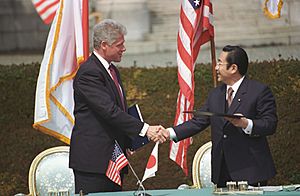

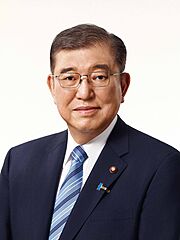
- Shigeru Ishiba, the current Prime Minister of Japan (since 2024).
- Junichiro Koizumi, Prime Minister of Japan from 2001 to 2006.
- Ryutaro Hashimoto, Prime Minister of Japan from 1996 to 1998.
- Tsuyoshi Inukai, Prime Minister of Japan from 1931 to 1932.
- Ichirō Ozawa, a former leader of the Democratic Party of Japan.
- Yukio Ozaki, a former Mayor of Tokyo, known as the "Father of parliamentary politics" in Japan.
- Hirofumi Nakasone, a former Minister for Foreign Affairs.
Public Servants and International Organizations
- Takeshi Kasai, a Regional Director for the WHO.
- Shigeru Omi, also a Regional Director for the WHO.
- Kiyoko Okabe, the first female justice of the Supreme Court of Japan.
- Taro Takemi, a president of the World Medical Association.
Central Bank Governors
- Shigeaki Ikeda, a former Governor of The Bank of Japan.
- Makoto Usami, also a former Governor of The Bank of Japan.
- Tarisa Watanagase (Thai), Governor of the Bank of Thailand from 2006–2010.
Astronauts
- Chiaki Mukai, a JAXA astronaut and the first Japanese woman in space.
- Akihiko Hoshide, a JAXA astronaut.
Finance and Business Leaders
- Taizo Nishimuro, former chairman and CEO of Tokyo Stock Exchange.
- Akio Toyoda, President and CEO of Toyota Motor Corporation since 2009.
- Yutaka Katayama, the first president of Nissan Motors' U.S. operations.
- Hidetaka Miyazaki, President of FromSoftware, a famous game designer.
- Ichizō Kobayashi, founder of Hankyu Railway and the Takarazuka Revue.
- Lee Jae-yong, executive chairman of Samsung Electronics.
Academics
- Toshihiko Izutsu, a member of the Japan Academy.
- Akira Hayami, a member of the Japan Academy, known for the "Industrious Revolution" idea.
- Ken Sakamura, creator of the TRON operating system architecture.
- Jun Murai, known as "The Father of The Internet" in Japan.
- Joi Ito, former director of the MIT Media Lab.
Artists and Entertainers
- Shusaku Endo, a famous Japanese author.
- Yoshio Taniguchi, an architect known for redesigning the Museum of Modern Art in New York City.
- Fumihiko Maki, an architect who designed the Shonan Fujisawa Campus.
- Sho Sakurai, a singer, actor, and member of the group Arashi.
Notable Faculty
- Fukuzawa Yukichi, the founder of Keio University.
- Kohei Itoh, a physicist and current president.
- Kitasato Shibasaburō, a famous physician and bacteriologist.
- Ryogo Kubo, a prize-winning physicist.
- Junzaburo Nishiwaki, a poet.
- Yone Noguchi, a poet.
- Shuichi Nosé, known for the Nosé–Hoover thermostat.
|
See also
 In Spanish: Universidad de Keiō para niños
In Spanish: Universidad de Keiō para niños
- Auto-ID Labs
- Eliica
- Keio University Hospital
- Keio Media Centers (Libraries)
- Keio Medical Science Prize
- Keio Shonan-Fujisawa Junior & Senior High School
- Keio University Shonan Fujisawa Campus
- List of National Treasures of Japan (crafts: others)


